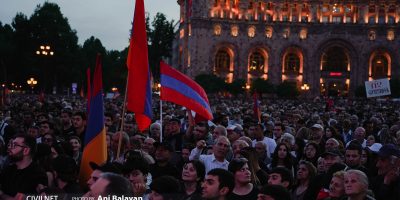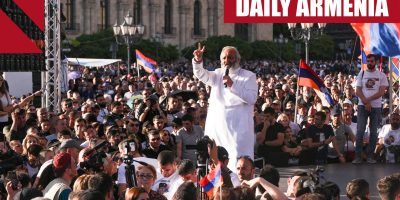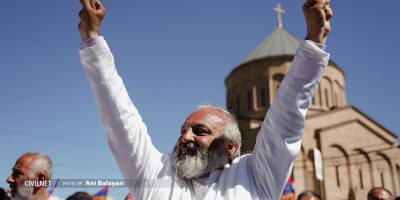Laurence Broers, renowned British expert on Nagorno-Karabakh has authored a book, entitled “Armenia and Azerbaijan. Anatomy of a Rivalry,” published by the Edinburgh University Press, 2019. Below is an excerpt from the book’s chapter “Questionable borders.”
From ‘Lighthouse’ to Fortress
In 1937, as if someone had flipped a switch, ‘Azerbaijani Turks’ (tyurki) became just ‘Azerbaijanis’ azerbaydzhantsy), and ‘Azerbaijani Turkic’ (tyurkskiy) became the ‘Azerbaijani’ (azerbaydzhanskiy) language. The change followed the 1936 dissolution of the Transcaucasian Socialist Federal Soviet Republic, the bureaucratic structure comprised of Armenia, Azerbaijan and Georgia, and the AzSSR’s formalisation as a separate unit of the Soviet Union. But there was more than bureaucratic expedience involved. The change also coincided with the Great Terror, and assumed its modalities. Accusations of pan-Turkism claimed thousands of lives. Historian Harun Yilmaz writes: ‘When the carnage came to an end in 1938, there were no experienced historians lett… Baku, an important center of Turkology before 1937, was deprived of Turkologists.’
 The AzSSR was one of several borderland units in the Soviet Union conceived in terms ot a ‘Piedmont principle’ projecting Soviet values beyond its borders. This kind of lighthouse policy’ emphasising cross-border commonality was vulnerable, however, to developments in the external identities to which such lighthouses were vectored and could reverse to a ‘fortress policy’ emphasising difference. The raw materials of nationhood ethnonyms, scripts and theories of origin – could change with regional and international winds. This was the case with the AzSSR. Through the 1920s and early 1930s its majority Turkic identity was seen as an asset in influencing neighbouring Turkic communities in the Middle East. But unlike similar ‘lighthouses’ in Moldova or Karelia, for example, Azerbaijan’s intended audiences were nor small and relatively marginal states like Romania or Finland, but the regional powers of Turkey and Iran. Vigorous nation-building efforts in Kemalist Turkey through the 1920s and 1930s redefined the meaning ot ‘Turk’ as the secular national identity of a new nation-state, Turkey. In Pahlavi Iran, nation-building over the same period centred on Persian history, culture and racial purity to portray the country’s Turkic minority identity as an unfortunate accident of history. Both of these developments unfavourably reflected onto the AzSSR’s Turkic identity. The Soviet lighthouse policy was exposed as being vulnerable to transformations in the external traditions of Turkishness it was meant to influence. Ironically, the Soviet state confronted essentially the same problem that Mamed Emin Rasulzade had faced twenty years previously: to define a national identity in Azerbaijan that would contain unwanted synergies with Turkic spaces on its borders. A defensive reformulation of the ethnic character of Azerbaijan – as fortress, not lighthouse was needed.
The AzSSR was one of several borderland units in the Soviet Union conceived in terms ot a ‘Piedmont principle’ projecting Soviet values beyond its borders. This kind of lighthouse policy’ emphasising cross-border commonality was vulnerable, however, to developments in the external identities to which such lighthouses were vectored and could reverse to a ‘fortress policy’ emphasising difference. The raw materials of nationhood ethnonyms, scripts and theories of origin – could change with regional and international winds. This was the case with the AzSSR. Through the 1920s and early 1930s its majority Turkic identity was seen as an asset in influencing neighbouring Turkic communities in the Middle East. But unlike similar ‘lighthouses’ in Moldova or Karelia, for example, Azerbaijan’s intended audiences were nor small and relatively marginal states like Romania or Finland, but the regional powers of Turkey and Iran. Vigorous nation-building efforts in Kemalist Turkey through the 1920s and 1930s redefined the meaning ot ‘Turk’ as the secular national identity of a new nation-state, Turkey. In Pahlavi Iran, nation-building over the same period centred on Persian history, culture and racial purity to portray the country’s Turkic minority identity as an unfortunate accident of history. Both of these developments unfavourably reflected onto the AzSSR’s Turkic identity. The Soviet lighthouse policy was exposed as being vulnerable to transformations in the external traditions of Turkishness it was meant to influence. Ironically, the Soviet state confronted essentially the same problem that Mamed Emin Rasulzade had faced twenty years previously: to define a national identity in Azerbaijan that would contain unwanted synergies with Turkic spaces on its borders. A defensive reformulation of the ethnic character of Azerbaijan – as fortress, not lighthouse was needed.
That reformulation was provided by a new tradition, which I term ‘proto-Azerbaijanism’. Reflecting a wider Soviet shift towards more primordially conceived identities, the new doctrine stressed autochthonism and the quest for pre-Turkic ancestors in antiquity, with the emphasis on the homeland of the AzSsR rather than theories admitting migration. Proto-Azerbaijanism, developed among others by Soviet Azerbaijani academicians lgrar Aliyev (1924-2004) and Ziya Buniyatov (1923-97), embedded two highly significant divisions within subsequent imaginings of Azerbaijan. First, at the intra-ethnic level proto0-Azerbaijanism resulted in a politically charged schism between the Turkic content of Azerbaijani identity and new theories of origin centred on the territory of Soviet Azerbaijan. The murder of thousands ot citizens on charges of pan-Turkism further embedded this schism, and retrospectively lent a nationalist, anti-Stalinist legitimacy to turcophile ideas. This perception was enhanced by the fact that shortly after redesignation, the Azerbaijan language converted on 1 January 1940 to a cyrillicised script, after Latinisation had displaced Arabic in the 1920s. In less than twenty years two generations of Azerbaijanis had been separated from their literary past; now they were renamed as a new nation and forced to use a Cyrillic script.
Second, proto-Azerbaijanism lent the division with Iranian Azerbaijan an air of historical authenticity. lt asserted the existence of a contained geo-body north of the Aras, rather than a macro-Turkic geo-body traversing it. New theories minimised the role of medieval Turkic migrations in the origins of the Azerbaijanis, and emphasised autochthonous elements instead. The doctrine conjured pre-Turkic ancestors among the Iranian Medians and the Caucasian Albanians, a previously little-known Christian people inhabiting parts of the eastern Caucasus until the eighth century. Proto-Azerbaijanism thereby aligned symbiotically with the dominant, unitary concept of Pahlavi Iranian nationalism, kasraviyya, predicated on Persian high culture, ancient history and racial unity. The two doctrines essentially concurred that Turkic ethno-linguistic continuity across the Aras an imagined community of all Azerbaijanis was the inauthentic residue of medieval migration that obscured a more fundamental historical divide.
The post-1937 Azerbaijanis were, as Charles King writes of the Moldovans another Soviet nationality subject to the political winds of lighthouse and fortress policies ‘a stipulated nation’: a bureaucratic requirement of super-ordinate Soviet political goals with an uncertain, contestable fit with local ethnographic realities. Proto-Azerbaijanism would define orthodox nationalism in the AzSSR throughout the later Soviet decades. As in Moldova, it gave rise to a political and cultural elite habituated and committed to an identity separate from the cultural identities of external powers. This elite did not perceive a single geo-body partitioned into north and south Azerbaijans. But a minority position maintained a pan-Azerbaijani perspective, encouraged in part by the Soviet Union’s own post-World War II foreign policy adventures in Iranian Azerbaijan.
Within just four years an unanticipated reprise of Azerbaijan’s ‘lighthouse’ role challenged the new ‘fortress’ identity. As part of the Allied occupation of Iran in 1941-6, the Soviet Union occupied Iranian Azerbaijan and other northern regions of Iran. Pan-Azerbaijani sentiments were encouraged as a possible prelude to a longer-term Soviet presence. In 1945 a year-long regional rebellion ensued in Iranian Azerbaijan, establishing a Provincial Government of Azerbaijan (PGA), beyond Tehran’s control and led by veteran communist Mir Jafar Pishevari (1893-1947).
Historians are divided on the relative roles of indigenous and external forces in the PGA episode, including Azerbaijani nationalism north and south of the Aras.24 While ethnic mobilisation in Iranian Azerbaijan served to highlight regional neglect by Tehran, on key symbolic issues the PGA proved tractable with Tehran. This indicated the limited political horizons- regional autonomy at most – to a southern Azerbaijani geopolitical tradition. The speed with which the PGA collapsed in December 1946 after Soviet withdrawal further signalled its dependence on the opportunity offered by the occupation.
The ‘Azerbaijan crisis’ marked an early confrontation in the nascent Cold War. Soviet acquiescence with American-British demands for withdrawal from Iran invested the division of Azerbaijan with a consensus on spheres of influence in the Middle East, allowing the Cold War’s frontline to relocate to Eastern Europe. But locally the encounter had posited the possibility of unification of the two Azerbaijans. This idea was more popular in the north, notably with AzSSR First Secretary Mir Jafar Baghirov and the many emissaries and cultural workers dispatched during World War II to Iranian Azerbaijan. Yet following the demise of the PGA, these sentiments became taboo. Expressions of pan-Azerbaijani sentiments were relegated to the cultural fringes such as the literature of longing, a subdued but consistent genre that lamented partition.
Photo: Eurasianet.org
















